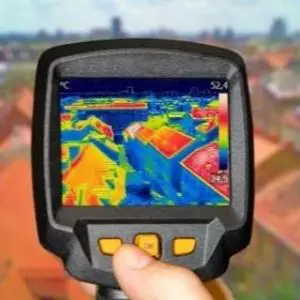Infrared light is a type of electromagnetic radiation with a longer wavelength than that visible light. It is sometimes also called infrared radiation or infrared energy. Infrared light has a range of applications in different fields, including astronomy, medicine, manufacturing, and communications. But how is it detected? Find out below.
How does infrared light work?
Infrared light is part of the electromagnetic spectrum, which means that it is a form of energy that travels through the air, just like radio waves, microwaves, and visible light.
But what sets infrared light apart from other types of EM radiation is its wavelength. Infrared wavelengths are longer than visible light wavelengths but shorter than microwaves. And because different objects emit infrared light at different wavelengths, we can use this light to see things that we can’t see with our eyes.
For example, have you ever used a remote control to turn on your TV? The remote control sends out a signal that is picked up by your TV’s receiver. That signal contains instructions for the TV, like “turn on” or “change channel.”
But how does the remote control know where your TV is? It uses infrared light! The remote control sends out a beam of infrared light that is focused onto your TV’s receiver. The receiver then reads the signal and turns on the TV.
How is infrared light used?
There are many ways that we use IR light in our everyday lives without even realizing it! Here are just a few examples:
- Thermometers: The most common way we use IR light is to measure temperature. Temperature is really just a measure of how quickly atoms are moving around. IR thermometers work by measuring the amount of IR radiation (heat) that is emitted by an object.
- Remote controls: Have you ever wondered how your TV remote control knows when to change the channel or turn the volume up? It’s because it uses a beam of IR light to communicate with your TV!
- Night vision cameras: Have you ever seen those movies where people have special glasses that allow them to see in the dark? It turns out that this technology actually exists, and it’s based on IR light! Night vision cameras detect the IR radiation emitted by objects and use it to create an image that we can see.
In astronomy, infrared light is used to detect objects that are too cold or too dusty to be seen in visible light. In medicine, infrared radiation is used in some types of medical imaging, such as thermography and near-infrared spectroscopy.
In manufacturing, infrared heaters are used to cure paints and coatings. And in communications, infrared technologies are used for short-range wireless data transfer (such as IrDA) and remote control (such as TV remote controls).
What are the benefits of using infrared light?
There are many benefits to using infrared light, including the ability to see in low-light conditions, detect heat signatures, and communicate with others using infrared signals.
What are the dangers of infrared light?
While infrared light is essential for vision, too much exposure to high-intensity infrared light can be dangerous. Prolonged exposure can lead to retinal burns, cataracts, and other serious injuries.
How can you detect infrared light?
There are a few ways that you can detect infrared light, including:
- Use a digital camera – most digital cameras have an infrared filter that can be removed, allowing you to see in the infrared spectrum.
- Use an infrared sensor – these are widely available and relatively inexpensive, making them a popular choice for detecting infrared light.
- Use your own body – if you have ever felt the heat from a distance, you have experienced infrared light!
What are some common uses for infrared light detectors?
Here are just a few examples of what infrared light detectors can be used for:
- Detecting leaks in pipes or other types of container
- Detecting overpriced items at the store (using an IR thermometer)
- Searching for missing people or animals in the dark
- Detection of fraudulent banknotes
What are the different types of infrared light detectors?
There are two main types of infrared light detectors: thermal or bolometric detectors and photoconductive or photovoltaic detectors. Each type of infrared detector has its own advantages and disadvantages.
Thermal detectors are the most common type of infrared detector. They work by measuring the change in temperature of a material when it is exposed to infrared light. Thermal detectors are very sensitive, but they have a slow response time and can only be used to measure steady-state infrared radiation.
Photoconductive or photovoltaic detectors are made of materials that change their electrical resistance when exposed to infrared light. These materials can be either semiconductors or metals. Photoconductive detectors are much faster than thermal detectors, but they are not as sensitive.
In Closing
Infrared light is everywhere around us. It is a type of electromagnetic radiation with a wavelength that is longer than visible light. Most of us are familiar with infrared technologies such as remote controls, thermal imaging, and night vision devices. And there are also ways to detect infrared light that make it not so much of a mystery.
NEXT UP: What Jobs Use Infrared Lights?

